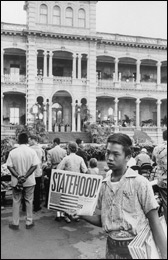Conflicts between the Polynesians who settled in Hawaii and whites began as early as 1779, when the locals clashed with English explorer Capt. James Cook and his crew. Cook became the first European to set foot on the islands the previous year, naming them the Sandwich Islands. On a return voyage, he and his men got into a dispute with the Hawaiians, who stabbed Cook to death in the surf.
In 1810, Kamehameha I became Hawaii’s first king, and 10 years later missionaries from New England arrived. This time, white people came to stay, although Hawaii remained mostly autonomous in the ensuing decades. When Queen Liliuokalani ascended to the throne in 1891, she drafted a new constitution that would strengthen the monarchy’s authority.
American and European businessmen then formed something called the Committee of Safety and sought U.S. military assistance to deal with a purported “imminent threat to American lives and property.” U.S. Marines and sailors were deployed and the queen relinquished her throne. President Grover Cleveland ordered an investigation. A report by former congressman James Henderson Blount concluded that the United States had abused its authority. Cleveland ordered the queen’s reinstatement, but provisional government president Sanford Dole, older cousin of the pineapple magnate James Dole, refused.
The Senate Foreign Relations Committee conducted its own probe and came to the opposite conclusion as Blount. The Republic of Hawaii was then established in 1894, with Dole as president. An attempt the following year to overthrow the republic was quashed, and Queen Liliuokalani was convicted and imprisoned for a year in Iolani Palace. In 1898, the United States annexed the islands. Hawaii became a territory.
Six decades later, President Dwight Eisenhower signed a bill allowing Hawaiian statehood, and 94% of residents voted on Aug. 21, 1959, in favor of it. Even so, there are today many sovereignty groups in Hawaii. One of them, the Hawaiian Kingdom Government, maintains that Hawaii has been “under prolonged occupation” by the United States and even filed an unsuccessful complaint with the United Nations Security Council in 2001.
On the 100th anniversary of the overthrow of Hawaii’s monarchy in 1993, Congress passed what became known as “The Apology Resolution,” expressing regret for the “suppression of the inherent sovereignty of the Native Hawaiian people.” President Bill Clinton signed the measure. It was about that time that “we started seeing more [Native Hawaiian] activism,” says state Sen. Sam Slom.
Hawaii Sen. Daniel Akaka later began regularly introducing a controversial bill that would recognize people of Native Hawaiian ancestry as a sovereign group, similar to Native American tribes. If passed, the bill would create a native-run government that would negotiate with the U.S. government for things like the transfer of lands. The legislation is pending before Congress.
Even pro-sovereignty advocates are divided over the bill, with opponents contending it would leave Hawaii still beholden to the U.S. government and hamper their efforts to restore the islands as an independent nation controlled by natives. Others, however, see the establishment of an independent Native Hawaiian government as a first step toward eventual independence.
— Larry Keller



